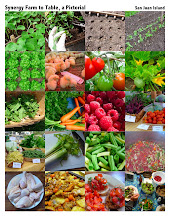skip to main |
skip to sidebar



- Bring a very big pot of generously salted water to a rolling boil (the kind that will quickly come back after you add your room temperature beans.)
- Add rinsed beans, in one pound batches, though that depends on just how big your pot is. Do not crowd the beans!!
- Boil , or as it is more technically called, blanch the beans for 2-3 minutes depending on just how big your beans are and whether or not you left them whole, or chose to cut them into 1 inch or 2 inch segments.
- Drain immediately and rinse under cold water to stop the cooking process. The key is that your beans are partially blanched, not completely blanched, before freezing.
- Shake the beans so that most of the water drips off and then lay them out of a baking sheet. If they seem really wet, pat them dry, to minimize ice crust formation on their surface.
- Then place your sheet, of well spread out beans in the freezer and come back to it in a half hour or so. What you are doing is beginning the freezing process in such a way that each bean freezes on its own, and not in a crammed, packed mass stuffed inside a ziploc bag. You want inidividual frozen beans, not a frozen ice block of beans.
- After a half hour or so of freezer time on the tray, go ahead and place them into ziploc bags with as much air as possible squeezed out of them.
- Come December, enjoy your summer green beans and snow peas by pulling out a bag full and blanching them straight from the freezer for 2-4 minutes in a big, well salted, rigorously boiling pot of water!!!!









No comments:
Post a Comment